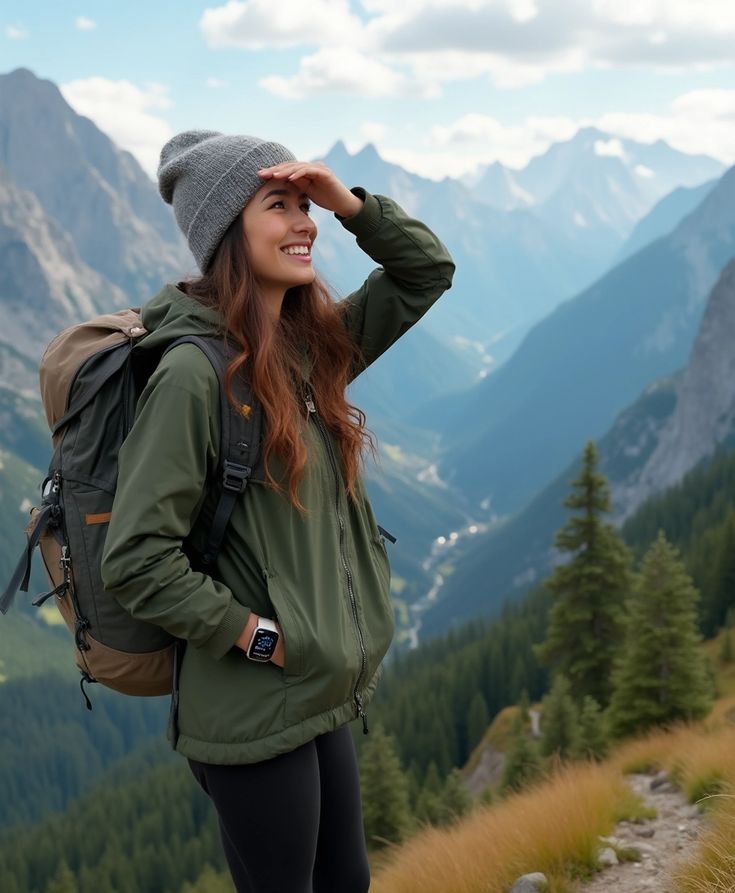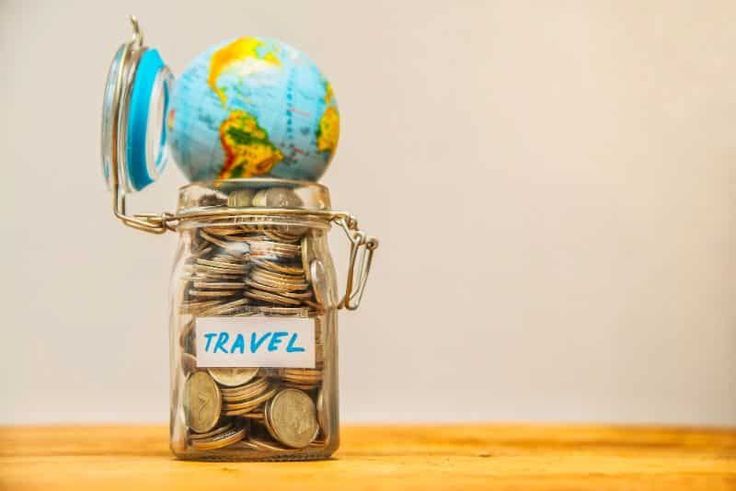Valley of Flowers Uttarakhand Overview
The Valley of Flowers Trek is a very beautiful place in Uttarakhand, India. It is in the Himalayan mountains and is famous for its colorful flowers and green meadows. During the monsoon season, the valley is covered with thousands of flowers of different colors. The air is fresh, the mountains are covered with snow, and the place feels very peaceful. It is a perfect spot for people who love nature and adventure.
This place is also a UNESCO World Heritage Site, which makes it very special. Many rare flowers grow here, like blue poppies, orchids, daisies, and primulas. These flowers do not grow in many other places. The valley also has small rivers, waterfalls, and snowy peaks around it, making it look like a dreamland.
The Valley of Flowers Trek is also home to many animals. Rare animals like snow leopards, musk deer, blue sheep, and Himalayan bears live here. Many beautiful birds can also be seen flying around. This makes the valley an important place for nature and wildlife.
To visit the Valley of Flowers Trek, people have to go on a trek (walk in the mountains). The journey is full of adventure and beauty. It is a great place for nature lovers, photographers, and trekkers. Anyone who visits this valley will feel like they have stepped into a fairy tale world. It is truly a must-visit place for everyone.
Valley of Flowers Trek Best Time to Visit

The best time to visit the Valley of Flowers Trek is from July to September. During this time, the valley is in full bloom with thousands of colorful flowers covering the meadows. The monsoon rains help the flowers grow, making the valley look like a natural paradise.
In July, the first flowers start blooming, and the valley turns green. August is the peak season when the maximum number of flowers are in full bloom. By September, the flowers begin to fade, but the valley still looks beautiful with lush greenery and clear views of the Himalayan mountains.
The weather during these months is cool and pleasant, perfect for trekking and sightseeing. Winter months (October to June) are not suitable as the valley remains covered in snow and is closed for visitors. So, if you want to see the valley at its best, plan your trip between July and September.
How to Reach Valley of Flowers Trek
Reaching the Valley of Flowers Trek involves multiple steps, including air, rail, road, and trekking. The trek starts from Govindghat, a small town in Uttarakhand, and requires a total trek of 17 km to reach the valley.
By Air:
The nearest airport is Jolly Grant Airport, Dehradun (about 292 km from Govindghat). From the airport, you can hire a taxi or take a bus to Joshimath and then to Govindghat.
By Train:
The nearest railway station is Rishikesh (about 273 km from Govindghat). You can find buses and taxis from Rishikesh to Govindghat. Haridwar Railway Station (around 290 km) is another good option.
By Road:
Govindghat is well connected by road. You can take a bus or taxi from Haridwar, Rishikesh, or Dehradun to Joshimath and then to Govindghat. Buses and shared taxis are available from these cities.
Trek to Valley of Flowers:
From Govindghat, trek 13 km to Ghangaria. You can also hire a mule or take a helicopter to Ghangaria. From Ghangaria, trek 4 km to reach the Valley of Flowers, where you can enjoy nature’s beauty.
Valley of Flowers Trek Temperature
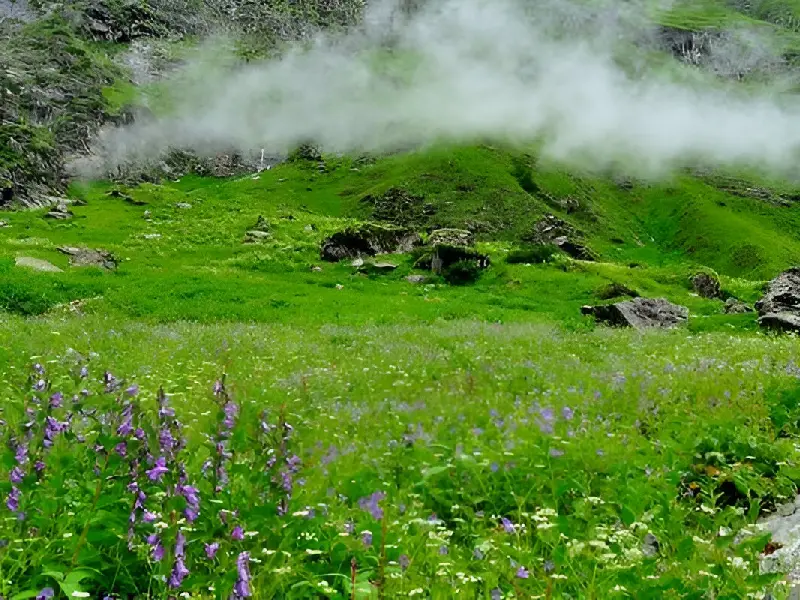
The best time to visit the Valley of Flowers Trek is during the monsoon season when the flowers are in full bloom. However, this trek can be challenging due to cold weather and heavy rainfall. It is always best to check the temperature and weather conditions before planning your trip. Below is a simple guide to the expected temperatures in different months.
May – Cold and Snowy
In May, the snow begins to melt, but some parts of the trek remain covered in snow, making the weather very cold. The temperature ranges from 8°C to -3°C. The valley is still mostly white with only a few flowers starting to bloom.
June – Pleasant Weather
June is one of the best months to visit. The temperature ranges from 11°C to 2°C, and there is little to no rainfall. The weather is comfortable, and more flowers begin to bloom, making the valley look stunning.
July – Warmer but Rainy
In July, the temperature rises slightly to 11°C to 6°C, making it more comfortable. However, moderate to heavy rainfall can be expected. The trek to Hemkund Sahib also becomes easier during this time.
August – Peak Blooming Season
August is the peak monsoon season, and the valley is filled with colorful flowers and lush greenery. The temperature ranges from 12°C to 6°C. This is the best time to see the valley at its most beautiful, but expect heavy rainfall.
September – Last Month to Visit
September is the last month to visit before the valley gets covered in snow. The temperature ranges from 11°C to 4°C, and there is little to no rainfall. After this month, the flowers start to fade, and the valley becomes inaccessible due to snowfall.
Things to Do on the Valley of Flowers Trek India
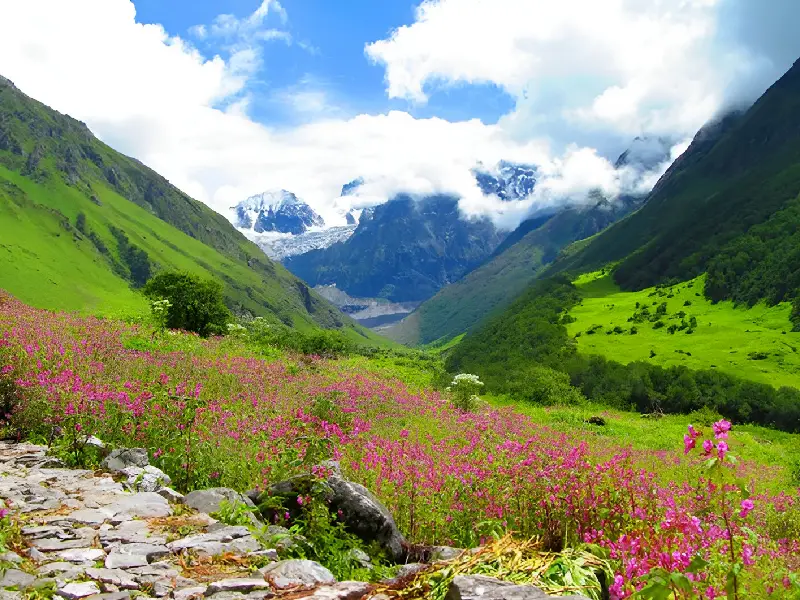
The Valley of Flowers Trek is not just about reaching the valley. There are many amazing things to see and do along the way. Here are some of the best experiences you can enjoy during the trek.
1. Walk Through Beautiful Nature
The trek takes you through green forests, small rivers, waterfalls, and snowy mountains. Walking in the fresh air, surrounded by the Himalayan peaks, makes the journey exciting and peaceful.
2. See Thousands of Colorful Flowers
The valley is full of beautiful flowers that bloom during the monsoon season. You can see blue poppies, orchids, daisies, and many other rare flowers. The valley looks like a colorful carpet of nature.
3. Visit Hemkund Sahib
A short trek from Ghangaria leads to Hemkund Sahib, a famous Sikh temple. It is located near a glacial lake at 4,632 meters. The peaceful surroundings and stunning views make it a special place to visit.
4. Spot Rare Animals and Birds
The valley is home to many wild animals and birds. You may see musk deer, blue sheep, Himalayan bears, or even a snow leopard. There are also many colorful birds flying around.
5. Stay at Ghangaria
Ghangaria is the base camp for the trek. You can stay overnight, enjoy campfires, and meet other travelers. It’s a great place to relax before or after the trek.
6. Take Beautiful Pictures
The trek offers amazing views at every step. You can click pictures of the valley, flowers, waterfalls, and mountains to keep memories of your trip.
The Valley of Flowers Trek is a perfect trip for those who love nature, adventure, and peace.
Valley of Flowers Trek Difficulty
The Valley of Flowers is at a height of 12,654 feet, while Hemkund Sahib Gurudwara is even higher at 15,197 feet. The total trek distance is around 37 km, including visits to both Valley of Flowers and Hemkund Sahib.
The trek has some easy parts and some steep climbs, making it moderately difficult. The high altitude and changing weather can make the trek challenging. Sometimes, the air gets thin, making it harder to breathe. Rainy weather also makes the trail slippery.
This trek is not too hard for beginners, but it does require good fitness. With proper preparation, anyone can complete this beautiful journey.
Other Treks and Places to Visit Near Valley of Flowers
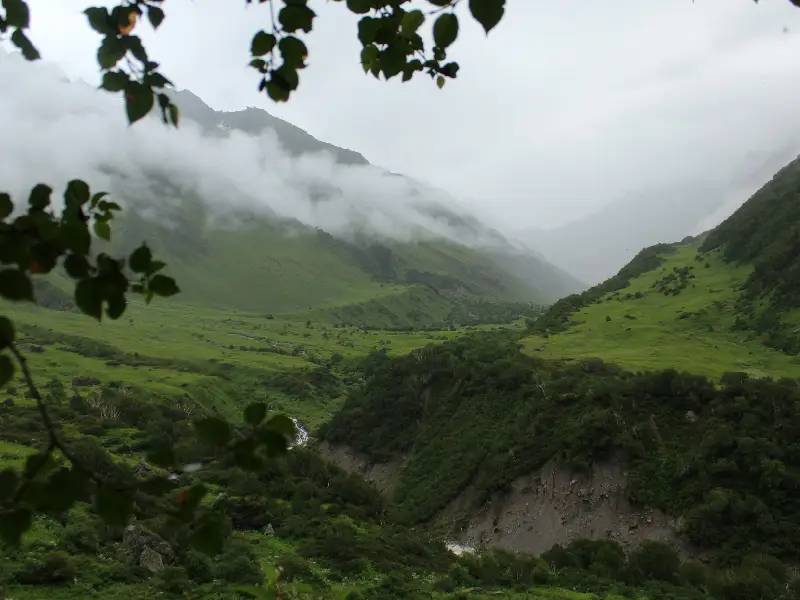
The Valley of Flowers is one of the most beautiful monsoon treks in India. But if you want to explore more places nearby, here are some amazing destinations you can add to your trip.
1. Badrinath Temple & Mana Village
Badrinath Temple is one of the most famous Hindu temples and a part of the Char Dham Yatra. It is located at 10,279 feet in the Himalayas and remains open from May to November. Nearby, you can visit Mana Village, the last Indian village near the Tibet border. This village is known for its old houses, handicrafts, and beautiful mountain views.
2. Tungnath Temple
Tungnath Temple is the highest Shiva temple in the world, located at 12,073 feet. It is a part of the Panch Kedar temples and is famous for the Chopta Tungnath Trek. The temple is best visited from May to November. During winter, the area is covered in snow, making it a winter wonderland.
3. Joshimath
Joshimath is the starting point of the Valley of Flowers Trek. It is an important religious town and home to the Narsingh Temple. You can also start treks to Kuari Pass, Bagini Glacier, and Nanda Devi Base Camp from here.
4. Auli
Auli is a famous winter destination near the Valley of Flowers. It is known for skiing, snowboarding, and cable car rides. If you love adventure or want to enjoy the snowy landscapes, Auli is a must-visit.
5. Dhari Devi Temple
The Dhari Devi Temple is located in the middle of the Alaknanda River. It is an important Hindu temple, where people believe the deity changes form throughout the day. Morning – a child, afternoon – a young lady, and evening – an old woman.
6. Panch Prayags (Sacred River Confluences)
While traveling to the Valley of Flowers, you can visit four out of the five Panch Prayags – Devprayag, Rudraprayag, Nandprayag, and Karnaprayag. These places are where two rivers meet, creating beautiful and peaceful sights.
If you love nature, spirituality, and adventure, adding these places to your Valley of Flowers trip will make your journey even more special.
Easy Tips and Tricks for Valley of Flowers Trek
The Valley of Flowers Trek is a beautiful journey, but it can be a little tough. With the right planning, you can enjoy it without any problems. Here are some simple tips and tricks to help you.
1. Best Time to Visit
- The best time to visit is July to September because the flowers are in full bloom.
- Avoid early June, as some areas may still have snow.
- September is a good time for clear weather, but some flowers may start fading.
2. Get Ready for the Trek
- The trek is around 17 km, so practice walking every day before your trip.
- Try climbing stairs and carrying a small backpack to build stamina.
- If you have breathing problems, talk to a doctor before going.
3. Pack Light and Smart
- Wear good trekking shoes that are strong and waterproof.
- Carry warm clothes because it gets cold, especially at night.
- Bring a raincoat or poncho, as it often rains during the trek.
- Use a comfortable backpack to carry your things easily.
4. Must-Carry Items
- Water bottle – Stay hydrated.
- Snacks like chocolates, dry fruits, and energy bars – They give quick energy.
- Medicines – For fever, cold, headache, and stomach problems.
- Sunscreen, sunglasses, and a cap – Protect yourself from the sun.
- Torch and extra batteries – Useful in low light.
- Walking stick – Helps you balance on steep paths.
5. Drink Water and Eat Well
- Drink 2-3 liters of water daily to stay fresh.
- Eat light and healthy food like fruits and vegetables.
- Avoid oily and heavy meals, as they can make trekking harder.
6. Trekking Tips
- Start your trek early in the morning to avoid rain and reach on time.
- Walk slowly and steadily, don’t rush.
- Take short breaks to rest, but don’t sit for too long.
- If you feel too tired, you can hire a mule or porter at Govindghat.
7. Respect Nature
- Do not pluck flowers or disturb animals.
- Keep a small bag for trash and don’t litter.
- Listen to your guide and follow local rules.
With good preparation, the Valley of Flowers Trek will be an amazing and fun experience!
Conclusion
The Valley of Flowers Trek is a dream destination for nature lovers, trekkers, and adventure seekers. With its colorful flowers, scenic landscapes, fresh air, and peaceful surroundings, it offers an unforgettable experience. The trek may be challenging, but with the right preparation and planning, it becomes enjoyable.
Visiting nearby places like Hemkund Sahib, Badrinath, and Auli can make the trip even more special. Respecting nature, staying fit, and carrying the right essentials will help you have a safe and memorable journey. If you love nature, trekking, and adventure, the Valley of Flowers is a must-visit place!
FAQs – Valley of Flowers
1. Which is the Best Season to Visit Valley of Flowers?
The best time to visit the Valley of Flowers is from July to September. During this time, the flowers are in full bloom, and the valley looks most beautiful.
2. Why is Valley of Flowers famous?
The Valley of Flowers is famous for its colorful flowers, rare plants, and beautiful scenery. It is also a UNESCO World Heritage Site and home to many rare animals like the snow leopard and musk deer.
3. Can we stay at Valley of Flowers?
No, staying overnight inside the Valley of Flowers is not allowed. The nearest place to stay in Ghangaria, which has hotels, lodges, and camps.
4. Do we need a permit to visit the Valley of Flowers?
Yes, visitors need a permit to enter the Valley of Flowers National Park. You can get the permit at the entry gate in Ghangaria.
5. Is a guide required for the Valley of Flowers trek?
No, hiring a guide is not mandatory, but it is helpful for first-time trekkers. A guide can provide information about flowers, animals, and the best routes.
6. What is the age limit for Valley of Flowers trek?
There is no fixed age limit, but the trek is moderate in difficulty. It is suitable for healthy children (above 10 years) and adults who can walk long distances.
7. Is Valley of Flowers a government site?
Yes, Valley of Flowers is a government-protected National Park and is managed by the Uttarakhand Forest Department.


